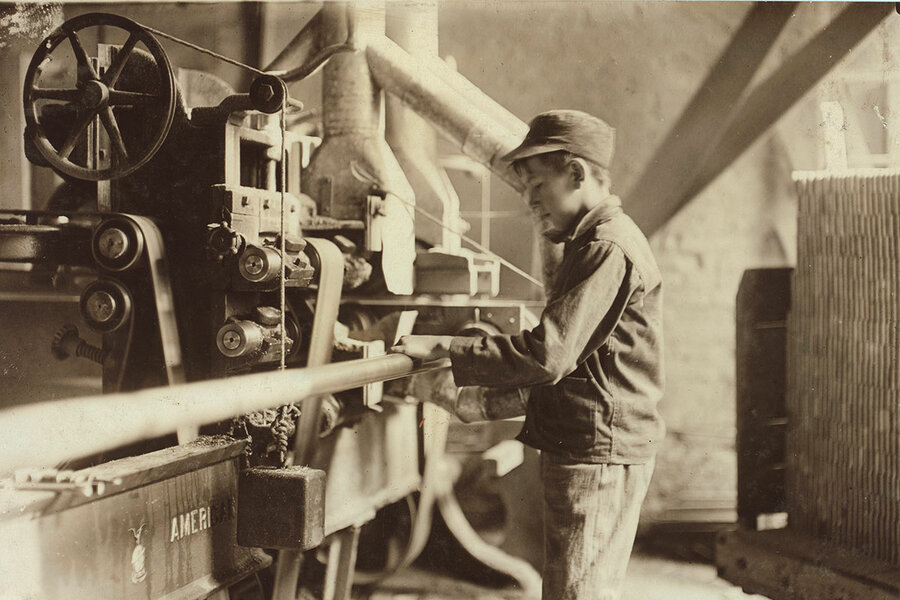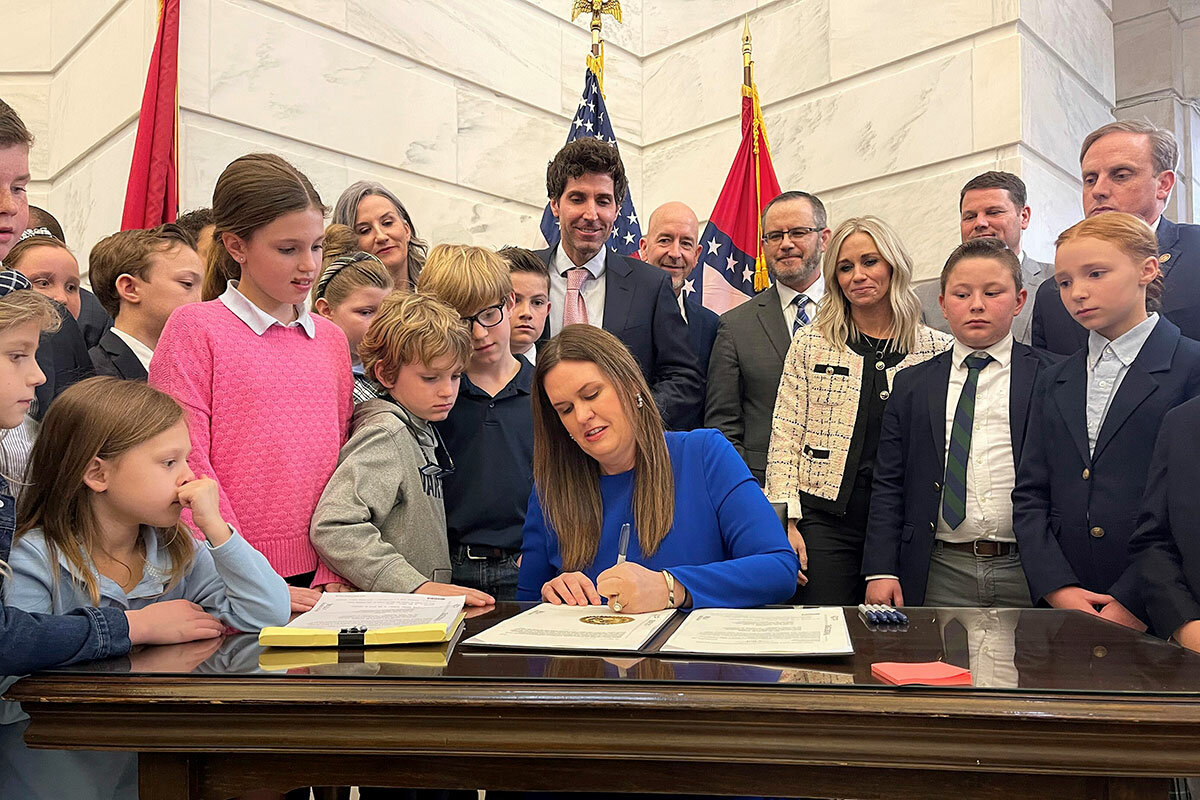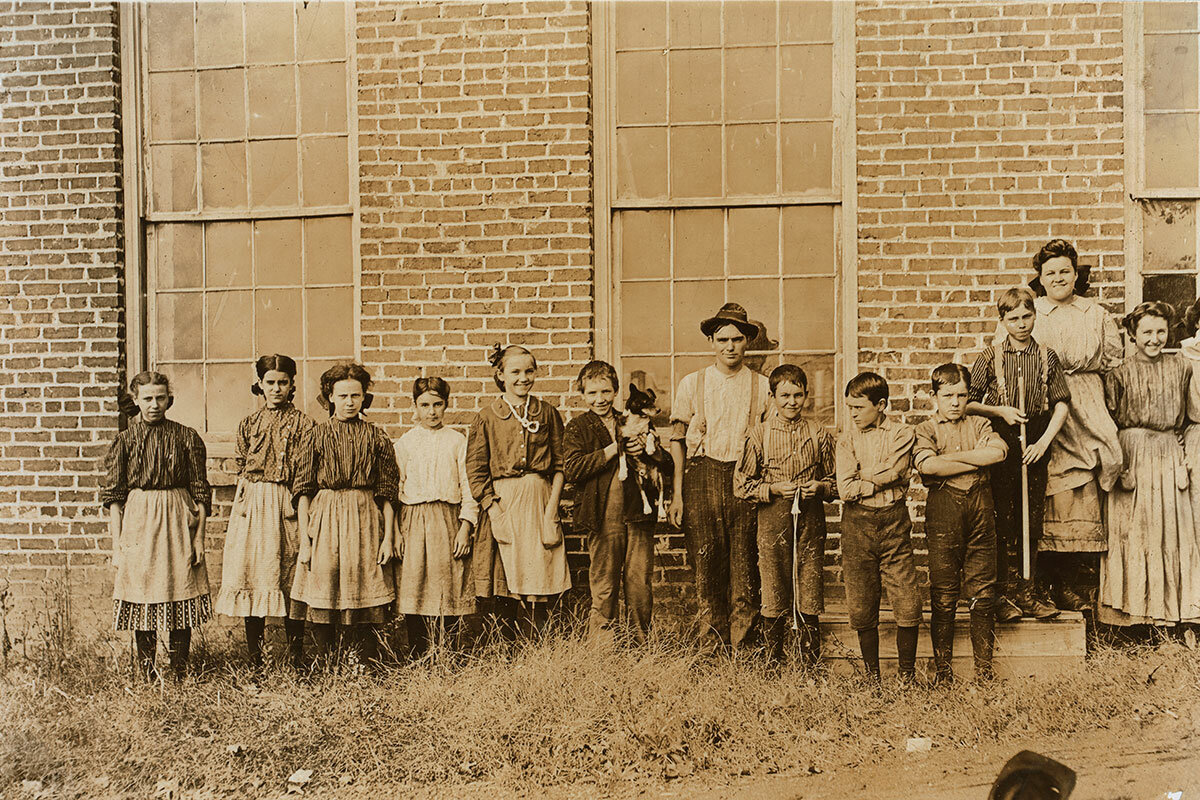Get a job: After 100 years, states loosen child labor laws
Loading...
| Austin, Texas
Since America’s rise as a global industrial power, the country’s use of child labor has only moved in one direction: less of it. Strict regulations and requirements around the jobs and hours minors can work have become the norm in a country where, a little more than a century ago, millions of children labored daily in fields and factories.
Led by state governments, a nation that saw children as necessary participants in the household economy shifted to a nation that saw children as valuable democratic citizens in need of education. And while child labor has never completely disappeared, it has diminished to a supplement of American childhood, not its defining feature.
Why We Wrote This
A story focused onWhat does it mean to have a childhood? As both red and blue states loosen child labor laws, Americans are debating questions that last came up at the beginning of the 20th century.
But is that now beginning to change? For the first time in history, the United States is engaged in a nationwide discussion over relaxing rules around children’s work. States are again leading the way, with legislatures in red and blue states alike debating – and passing – laws expanding the hours and kinds of settings minors can work in.
While there is nothing to suggest children will be moving en masse from schools to factories and slaughterhouses, the current push to relax those regulations has historical echoes. Today isn’t the first time there’s been a moral panic over parents’ rights or a Supreme Court skeptical of regulations. What will happen next is unclear, but the historical record is informative as America wrestles with questions it hasn’t debated for over a century.
Since America’s rise as a global industrial power, the nation’s use of child labor has only moved in one direction: less of it. Strict regulations and requirements around the jobs and hours minors can work have become the norm in a country where, a little more than a century ago, millions of children labored daily in fields and factories.
Led by state governments, a nation that saw children as necessary participants in the household economy shifted to a nation that saw children as valuable democratic citizens in need of education. And while child labor has never completely disappeared, it has diminished to a supplement of American childhood, not its defining feature.
But is that now beginning to change? For the first time in history, the United States is engaged in a nationwide discussion over relaxing rules around children’s work. States are again leading the way, with legislatures in red and blue states alike debating – and passing – laws expanding the hours and kinds of settings minors can work in. Similar bills have also been proposed in Congress.
- An Arkansas law, passed in March, eliminated age verification and governmental permission requirements for employers hiring minors.
- A New Jersey law, passed last year, extended the number of hours a minor can work per week to 50.
- In Iowa, a law enacted earlier this year permits children age 14 and older to use non-power-driven tools, and to work in kitchens and have “momentary work” in freezers and meat coolers.
- A Washington state law, passed in April, permits 18-year-olds to work in certain 21-and-older establishments, such as bars.
Why We Wrote This
A story focused onWhat does it mean to have a childhood? As both red and blue states loosen child labor laws, Americans are debating questions that last came up at the beginning of the 20th century.
While there is nothing to suggest children will be moving en masse from schools to factories and slaughterhouses, the current push to relax those regulations has historical echoes. Today is not the first time there’s been a moral panic over parents’ rights or a U.S. Supreme Court skeptical of regulations in general. What will happen next is unclear, but the historical record is informative as America wrestles with questions it hasn’t debated for over a century.
There was “a shift around, ‘what is childhood?’” in the early 1900s, says Beth English, executive director of the Organization of American Historians.
“It was, you have to be a participant in the household economy, and it shifted to, you have to be educated and able to participate in democracy,” she adds.
“We’re at [another] pivot point right now, and which way are we going to go?”
Citing a post-pandemic labor shortage and, in some cases, a desire to strengthen parents’ rights, the wave of legislation in recent years ranges from eliminating youth work permit and age verification requirements, to allowing minors to work longer hours during the school year, to allowing teenagers to serve alcohol. Some laws increase the penalties for violating child labor laws – typically a civil violation punished with fines – and indeed, the effort to relax child labor regulations comes as the Department of Labor has reported a significant increase in federal child labor violations in the past decade. The federal government is also investigating reports of widespread and unlawful use of unaccompanied migrant children in workplaces around the country.
Critics say the trend reflects a desire to hire more low-wage workers, at the short-term risk of children’s health and safety and the long-term risk of poorer educational outcomes. There’s a reason child labor regulations haven’t been touched in over a century, they argue, and it’s because they work.
“There’s really no evidence backing these policy decisions to weaken” child labor regulations, says Nina Mast, an analyst at the left-leaning Economic Policy Institute. ”The standards we have in place, they should only be strengthened, not rolled back.”
Lawmakers and advocacy groups pushing to relax these regulations didn’t respond to the Monitor’s interview requests, but a statement from Rep. Dusty Johnson, the Republican congressman for South Dakota, announcing a bill that would loosen federal limits on work hours for 14- and 15-year-olds illustrates why some believe some marginal changes are needed.
“If a high school student can play in a football game until 9 p.m., or play video games late into the evening, they should also be allowed to hold a job if they wish to,” he said. (The bill has since been withdrawn.)
Roots of child labor
It used to be not just normal for America’s children to work, but expected. When the country was mostly agrarian, children would help their families with farm work. And as the country industrialized and urbanized, child labor moved from the fields to factories and textile mills. The 1900 Census reported that about 2 million children were working across the United States.
By then, a reform movement had begun to gain traction. States, particularly in the North where child labor was most prevalent, started passing laws restricting it. By the turn of the century child labor had become a national issue. The National Child Labor Committee, formed in 1904, led efforts to pass federal legislation regulating children’s work.
For decades, these efforts were unsuccessful. Mill and factory owners opposed increased regulation, and many parents helped their children circumvent state regulations so they could boost the family’s income. But perhaps the toughest hurdle for reformers to overcome was the Supreme Court. Congress passed laws regulating child labor in 1916 and 1919, but the justices declared both to be unconstitutional.
Those rulings were among many issued by the high court during its so-called Lochner era, in which the justices often struck down laws – particularly President Franklin Roosevelt’s New Deal policies – thought to inhibit business and commercial interests. In 1937, the justices reversed course after Roosevelt threatened to pack the court. The Supreme Court upheld the Fair Labor Standards Act (FLSA) in 1938, which significantly restricted the kinds of jobs and number of hours children could work.
The FLSA, combined with World War II and post-war economic boom, “make it such that children aren’t actively working in industry in the kinds of numbers we used to see,” says Dr. English. Between 1900 and 1945, the number of children graduating high school increased from 6.4% to 51%.
The FLSA has set the floor of child labor standards in the U.S. ever since, but it has always left states wiggle room. The law doesn’t restrict the hours that employees age 16 and older can work, for example, but most states do. While it prohibits minors from working hazardous jobs, minors can work those jobs if it’s a fellowship-style program.
“There’s a lot of nuance there,” says Landon Jacquinot, a policy associate at the National Conference of State Legislatures. “Where states have been loosening those regulations is in those gray areas where it’s a bit less clear.”
Parents’ rights
Indeed, none of the legal changes in the past few years are sending children back into coal mines. But there are historical echoes in the current push to relax child labor rules.
The current Supreme Court, for example, disfavors efforts to regulate business and commercial interests. And parents’ rights is once again at the forefront of debate.
Courts broadly considered children the property of their parents in the post-Civil War United States, and opponents of early child labor laws would argue that they violated parental rights, according to the U.S. Bureau of Labor Statistics. Now, parents’ rights – which have animated criticism of public education in recent years – are being cited in the child labor space again.
Families “want more of the freedom that lets our children flourish,” wrote Nick Stehle, vice president of the Foundation for Government Accountability, a conservative think tank that has lobbied to relax child labor laws around the country, in a Fox News op-ed in March.
Youth workers are also needed to help address a post-pandemic labor shortage in the country, supporters say.
“Keeping a schedule, collaborating with others, discovering your skills and your shortcomings ... complement what you learn in the classroom,” said Mr. Stehle in his op-ed.
“Can anyone honestly say that American teenagers are more responsible and well-rounded now than they were 50 years ago?” he added.
Statistics in fact show that over the past four decades, the youth crime rates and teen pregnancy rates have declined continuously, while graduation rates in the U.S. have steadily increased to the highest on record in 2020.
The recent spate of bills also come at a time when the number of minors employed in violation of federal law almost tripled between 2013 and 2022, according to the Department of Labor. Some of the bills do add teeth to child labor enforcement, however. Arkansas created a criminal penalty – where civil penalties are most common – for employers who knowingly violate the law. A bipartisan bill in Congress would impose “stronger criminal penalties for repeat or willful violations,” reported Reuters.
There are historic echoes even when it comes to migrant labor. In 1870s New York City, “padrones” promised Italian parents apprenticeships for their children, only to force them into street labor and keep all their wages. The arrangement bears striking resemblance to the exploitation that migrant children are experiencing around the country, working to pay sponsors who helped them get into the country, according to a New York Times investigation.
Supporters of loosening child labor laws point to teenagers’ declining labor force participation in recent years, particularly a sharp decline in summer jobs reported by the Pew Research Center eight years ago.
But that may be a result of economic incentives shifting, data shows. As children have spent less time working in recent decades, they have spent more time in school. Recent studies have shown that education increases a person’s career earnings and reduces their risk of unemployment, and that working more hurts school success and completion.
While the recent spate of bills do loosen some restrictions on child labor, the changes are marginal – indeed marginal enough to pass in both Republican- and Democrat-controlled statehouses.
But policymaking at the state level can be, depending on your perspective, a momentum builder or a slippery slope. State-level child labor regulations, historians note, paved the way for federal action. Activists are concerned that the trend may now be moving in the opposite direction.
“A crux of a lot of the debate [150 years ago] was that child labor was necessary” given the state of the economy, says Dr. English. Today, in a post-pandemic economy, with low unemployment, high wages, and high inflation, “some people are saying it’s logical to employ children again.”
“The question becomes, what are the longer-term impacts of that on well-being, on education, on lifetime potential earnings?” she adds. The most important questions “might not be the work itself, but what are the ripple effects of that work?”










